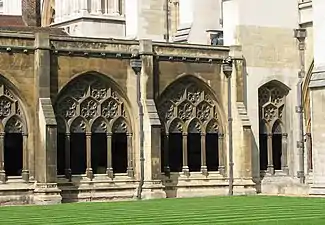Burials and memorials in Westminster Abbey
Honouring individuals buried in Westminster Abbey has a long tradition.
History
Henry III rebuilt Westminster Abbey in honour of the Royal Saint Edward the Confessor, whose relics were placed in a shrine in the sanctuary and now lie in a burial vault beneath the 1268 Cosmati mosaic pavement, in front of the high altar. Henry III was interred nearby in a chest tomb with effigial monument. Many of the Plantagenet kings of England, their wives and other relatives, were also buried in the abbey. From the time of Edward the Confessor, until the death of George II in 1760, most kings and queens of England were buried here, although there are exceptions (most notably Edward IV, Henry VIII and Charles I, who are buried in St George's Chapel, Windsor Castle). All monarchs who died after George II were buried in Windsor; most were laid to rest in St George's Chapel, although Queen Victoria and Edward VIII are buried at Frogmore, where the royal family has a private cemetery.
Since the Middle Ages, aristocrats were buried inside chapels, while monks and other people associated with the abbey were buried in the cloisters and other areas. One of these was Geoffrey Chaucer, who was employed as master of the King's Works and had apartments in the abbey. Other poets, writers and musicians were buried or memorialised around Chaucer in what became known as the Poets' Corner. These include: W. H. Auden, William Blake, Lord Byron, Charles Dickens, John Dryden, George Eliot, T. S. Eliot, Thomas Gray, Gerard Manley Hopkins, Samuel Johnson, John Keats, Rudyard Kipling, Jenny Lind, John Masefield, John Milton, Laurence Olivier, Alexander Pope, Nicholas Rowe, Percy Bysshe Shelley, Thomas Shadwell, Alfred Tennyson and William Wordsworth. Abbey musicians such as Henry Purcell were also buried in their place of work.
Subsequently, it became one of Britain's most significant honours to be buried or commemorated there.[1]
The practice of burying national figures in the abbey began under Oliver Cromwell with the burial of Admiral Robert Blake, in 1657.[2] The practice spread to include generals, admirals, politicians, doctors and scientists such as Sir Isaac Newton, buried on 4 April 1727 and Charles Darwin, buried on 19 April 1882.
British Prime Ministers buried in the abbey are: William Pitt the Elder, William Pitt the Younger, George Canning, Viscount Palmerston, William Ewart Gladstone, Bonar Law, Neville Chamberlain and Clement Attlee.
During the early 20th century, for reasons of space, it became increasingly common to bury cremated remains rather than coffins. In 1905, the actor Sir Henry Irving was cremated and his ashes buried in the abbey, thereby becoming the first person ever to be cremated prior to interment.[3] This marked a milestone as after the death of Sir Joseph Dalton Hooker in December 1911, the Dean and Chapter of Westminster Abbey chose to offer Hooker a grave near Charles Darwin's in the nave, but also insisted that he be cremated before. His widow however declined and so Hooker's body was buried in the churchyard of St Anne's Church, Kew. The majority of interments are of cremated remains, but some burials still take place – Frances Challen, wife of the Rev. Sebastian Charles, Canon of Westminster, was buried alongside her husband in the south choir aisle in 2014.[4] Members of the Percy family have a family vault, "The Northumberland Vault", in St Nicholas's Chapel, within the abbey.[5] The ashes of physicist Stephen Hawking were interred in the abbey on 15 June 2018, near the grave of Sir Isaac Newton.[6][7] The memorial stone, bearing the inscription 'Here lies what was mortal of Stephen Hawking 1942–2018', includes a form of the Bekenstein–Hawking entropy equation relating to black holes.[7]
In the floor just inside the great west door, in the centre of the nave, is the tomb of The Unknown Warrior, an unidentified British soldier killed on a European battlefield during the First World War. He was buried in the abbey on 11 November 1920. There are many graves in the floors, but this is the only grave on which it is forbidden to walk.[8]
Burials
- See also: Category:Burials at Westminster Abbey
British monarchs and consorts
The following English, Scottish and British monarchs and consorts are buried in the abbey:
- Edward the Confessor, King of England, in 1066
- Edith of Wessex, Queen of England; wife of Edward the Confessor
- Henry III, King of England
- Eleanor of Castile, Queen of England, in 1290 (viscera at Lincoln Cathedral and heart at Blackfriars, London); wife of Edward I
- Edward I, King of England, in 1307
- Philippa of Hainault, Queen of England, in 1370; wife of Edward III
- Edward III, King of England, in 1377
- Anne of Bohemia, Queen of England, in 1394; wife of Richard II
- Richard II, King of England, in 1413 (reburial from King's Langley Priory)
- Henry V, King of England, in 1422
- Catherine of Valois, Queen of England; wife of Henry V
- Possibly the Princes in the Tower (Edward V, King of England, and his younger brother, Richard of Shrewsbury, Duke of York),[lower-alpha 1] sons of Edward IV and Elizabeth Woodville
- Anne Neville, Queen of England, in 1485; wife of Edward of Westminster, Prince of Wales and Richard III
- Elizabeth of York, Queen of England, in 1503; wife of Henry VII
- Henry VII, King of England, in 1509
- Edward VI, King of England, in 1553
- Anne of Cleves, Queen of England, in 1557; fourth wife of Henry VIII
- Mary I, Queen of England, in 1558
- Mary, Queen of Scotland and Queen Dowager of France, in 1612 (reburial from Peterborough Cathedral); mother of James VI and I
- Elizabeth I, Queen of England, in 1603[lower-alpha 2]
- Anne of Denmark, Queen of England and Scotland, in 1619; wife of James VI and I
- James VI and I, King of England and Scotland, in 1625[lower-alpha 3]
- Charles II, King of England and Scotland, in 1685
- Mary II, Queen of England and Scotland, in 1695
- William III, King of England and Scotland, in 1702
- Prince George of Denmark, Duke of Cumberland, in 1708; husband of Anne, Queen of Great Britain
- Anne, Queen of Great Britain, in 1714
- Caroline of Ansbach, Queen of Great Britain, in 1737; wife of George II
- George II, King of Great Britain, in 1760
Other royal relatives
- Edmund Crouchback, Earl of Leicester and Lancaster, in 1301; son of Henry III and Eleanor of Provence
- Katherine of England; daughter of Henry III and Eleanor of Provence
- Henry of England, in 1274; son of Edward I and Eleanor of Castile
- Alphonso of England, Earl of Chester, in 1284 (heart at Blackfriars, London); son of Edward I and Eleanor of Castile
- Eleanor of England, Countess of Bar, in 1298; daughter of Edward I and Eleanor of Castile
- John of Eltham, Earl of Cornwall, in 1337; son of Edward II and Isabella of France
- Thomas of Woodstock, Duke of Gloucester, in 1397; son of Edward III and Philippa of Hainault
- Eleanor de Bohun, Duchess of Gloucester, in 1399; wife of Thomas of Woodstock
- Elizabeth Tudor, in 1495; daughter of Henry VII and Elizabeth of York
- Edmund Tudor, Duke of Somerset, in 1500; son of Henry VII and Elizabeth of York
- Lady Margaret Beaufort, Countess of Richmond and Derby; mother of Henry VII
- Henry Tudor, Duke of Cornwall, in 1511; son of Henry VIII and Catherine of Aragon
- Charles Stuart, 1st Earl of Lennox; great-grandson of Henry VII and paternal uncle to James VI and I
- Lady Margaret Douglas, Countess of Lennox; daughter of Margaret Tudor and Archibald Douglas, 6th Earl of Angus
- Henry Frederick Stuart, Prince of Wales, in 1612; son of James VI and I and Anne of Denmark
- Lady Arbella Stuart; great-great-granddaughter of Henry VII and paternal cousin to James VI and I
- Charles James Stuart, Duke of Cornwall; infant son of Charles I and Henrietta Maria of France
- Anne Stuart, in 1640; infant daughter of Charles I and Henrietta Maria of France
- Mary Stuart, Princess Royal and Princess consort of Orange, in 1660; daughter of Charles I and Henrietta Maria of France; mother of William III
- Henry Stuart, Duke of Gloucester, in 1660; son of Charles I and Henrietta Maria of France
- Charles Stuart, Duke of Cambridge, in 1661; son of James II and Anne Hyde
- Elizabeth Stuart, Electress consort of the Palatinate and Queen consort of Bohemia, in 1662; daughter of James VI and I and Anne of Denmark; grandmother of George I
- James Stuart, Duke of Cambridge, in 1667; son of James II and Anne Hyde
- Charles Stuart, Duke of Kendal, in 1667; son of James II and Anne Hyde
- Anne (née Hyde), Duchess of York and Albany, in 1671; first wife of James II
- Edgar Stuart, Duke of Cambridge, in 1671; son of James II and Anne Hyde
- Prince Rupert of the Rhine, Duke of Cumberland, in 1682; son of Elizabeth Stuart and Frederick V, Elector Palatine of the Rhine
- Prince William, Duke of Gloucester, in 1700; son of Anne, Queen of Great Britain and Prince George of Denmark
- Other infant children of Anne, Queen of Great Britain
- Prince George William of Great Britain, in 1718; infant son of George II and Caroline of Ansbach
- Frederick, Prince of Wales, in 1751; son of George II and Caroline of Ansbach; father of George III
- Princess Caroline of Great Britain, in 1758; daughter of George II and Caroline of Ansbach
- Princess Elizabeth of Great Britain, in 1759; daughter of Frederick, Prince of Wales and Augusta of Saxe-Gotha-Altenburg
- Prince William, Duke of Cumberland, in 1765; son of George II and Caroline of Ansbach
- Prince Frederick of Great Britain, in 1766; son of Frederick, Prince of Wales and Augusta of Saxe-Gotha-Altenburg
- Prince Edward, Duke of York and Albany, in 1767; son of Frederick, Prince of Wales and Augusta of Saxe-Gotha-Altenburg
- Princess Louisa of Great Britain, in 1768; daughter of Frederick, Prince of Wales and Augusta of Saxe-Gotha-Altenburg
- Augusta of Saxe-Gotha-Altenburg, Princess of Wales, in 1772; wife of Frederick, Prince of Wales
- Prince Alfred of Great Britain, in 1782 (later moved to St George's Chapel, Windsor Castle); son of George III and Charlotte of Mecklenburg-Strelitz
- Prince Octavius of Great Britain, in 1783 (later moved to St. George's Chapel, Windsor Castle); son of George III and Charlotte of Mecklenburg-Strelitz
- Princess Amelia of Great Britain, in 1786; daughter of George II and Caroline of Ansbach
- Prince Henry, Duke of Cumberland and Strathearn, in 1790; son of Frederick, Prince of Wales and Augusta of Saxe-Gotha-Altenburg
Nave
The following are buried in the nave:
- Field Marshal Edmund Allenby, 1st Viscount Allenby
- John André
- The Right Reverend Francis Atterbury, Bishop of Rochester
- Clement Attlee, 1st Earl Attlee
- Sir Charles Barry
- Ernest Bevin
- Angela Burdett-Coutts, 1st Baroness Burdett-Coutts
- Neville Chamberlain
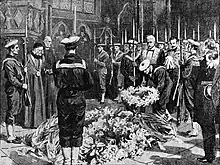
- Admiral of the Red Thomas Cochrane, 10th Earl of Dundonald and Marquess of Maranhão
- Vice Admiral Charles Cornewall
- Charles Darwin
- Joost de Blank, Archbishop of Cape Town
- Freeman Freeman-Thomas, 1st Marquess of Willingdon
- George Graham
- Stephen Hawking
- Sir John Herschel, 1st Baronet
- John Hunter (surgeon)
- Benjamin "Ben" Jonson (buried upright)
- Andrew Bonar Law
- David Livingstone (heart buried in Zambia)
- Sir Charles Lyell, 1st Baronet
- Sir Isaac Newton
- Field Marshal Herbert Plumer, 1st Viscount Plumer
- Ernest Rutherford, 1st Baron Rutherford of Nelson
- Sir George Gilbert Scott
- Robert Stephenson
- Ludovic Stewart, 2nd Duke of Lennox and 1st Duke of Richmond
- George Edmund Street
- Sir Joseph John "J.J." Thomson
- William Thomson, 1st Baron Kelvin
- Thomas Tompion
- The Unknown Warrior (entombed in 1920)
- Beatrice Webb, Baroness Passfield
- Sidney Webb, 1st Baron Passfield
North transept

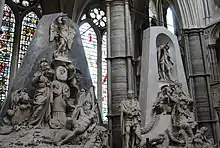
The following are buried in the north transept:
- George Canning
- Charles Canning, 1st Earl Canning
- William Pitt the Elder, 1st Earl of Chatham
- Charles James Fox
- William Ewart Gladstone
- Henry Grattan
- William Pitt the Younger
- Major General Sir John Malcolm
- David Murray, 2nd Earl of Mansfield and 7th Viscount of Stormont
- William Murray, 1st Earl of Mansfield
- Theodore Paleologus II
- Robert Stewart, 2nd Marquess of Londonderry
- Henry John Temple, 3rd Viscount Palmerston
- Sir Hugh Vaughan
- William Wilberforce
South transept
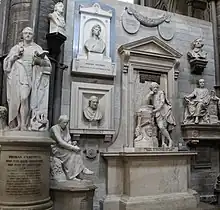
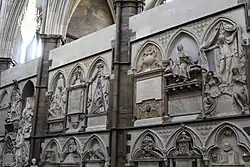
The following are buried in the south transept which is known as the Poets' Corner:
- Robert Adam
- Robert Browning
- William Camden
- Thomas Campbell
- Geoffrey Chaucer
- William Congreve
- Abraham Cowley
- Sir William Davenant
- Sir John Denham
- Charles Dickens
- Michael Drayton
- John Dryden
- Adam Fox
- David Garrick
- John Gay
- Gabriel Goodman
- George Frideric Handel
- Thomas Hardy (heart buried in Stinsford)
- Sir Henry Irving
- Samuel Johnson
- Rudyard Kipling
- Thomas Babington Macaulay, 1st Baron Macaulay
- John Masefield
- Anne Oldfield
- Laurence Olivier, Baron Olivier
- Thomas "Old Tom" Parr
- Richard Brinsley Sheridan
- Edmund Spenser
- Alfred Tennyson, 1st Baron Tennyson
Cloisters
The following are buried in the cloisters:
- Edmund Ayrton[11]
- Aphra Behn
- General John Burgoyne
- Muzio Clementi
- Benjamin Cooke
- Robert Cooke
- Percival "Percy" Dearmer
- Laurence of Durham, Abbot c. 1158–1173[12]
- Ian Fraser, Baron Fraser of Lonsdale
- Jeremy Heywood, Baron Heywood of Whitehall
- William de Humez, Abbot 1214–1222[13]
- Howard Nixon
- John Parsons
- Johann Peter Salomon
- William Shield
- Herbert Thorndike
- John Thorndike
- William Turner
- James Wright[14]
North choir aisle

The following are buried in the north choir aisle:
South choir aisle
The following are buried in the south choir aisle:
- Andrew Bell
- James Kendall
- Sir Paul Methuen
- Admiral of the Fleet Sir Cloudesley Shovell
- Dame Sybil Thorndike, Lady Casson
- Charles Whitworth, 1st Baron Whitworth[15]
Ambulatory chapels
The following are buried in the ambulatory chapels:
St. John the Baptist Chapel
- Thomas Cecil, 1st Earl of Exeter
- Dorothy Cecil, Countess of Exeter; first wife of Thomas Cecil and daughter of John Neville, 4th Baron Latimer
St. Nicholas' Chapel
Northumberland Vault:[5]
- George Seymour, Viscount Beauchamp; only son of Algernon Seymour, 7th Duke of Somerset
- General Algernon Seymour, 7th Duke of Somerset
- Frances Seymour, Duchess of Somerset; wife of Algernon Seymour, 7th Duke of Somerset and paternal granddaughter of Thomas Thynne, 1st Viscount Weymouth
- Lady Elizabeth Percy; only daughter of Hugh Percy, 1st Duke of Northumberland
- Elizabeth Percy, Duchess of Northumberland and 2nd Baroness Percy; wife of Hugh Percy, 1st Duke of Northumberland and daughter of Algernon Seymour, 7th Duke of Somerset
- Elizabeth Percy; second daughter of Algernon Percy, 1st Earl of Beverley
- Lady Charlotte Percy; eldest daughter of Hugh Percy, 2nd Duke of Northumberland
- Hugh Percy, 1st Duke of Northumberland
- Lord Henry Percy; second son of Hugh Percy, 2nd Duke of Northumberland
- Lady Louisa Percy; fifth daughter of Algernon Percy, 1st Earl of Beverley
- Hon. Algernon Percy; eldest son of George Percy, 5th Duke of Northumberland
- Hon. Henry Percy; second son of George Percy, 5th Duke of Northumberland
- Hon. Margaret Percy; second daughter of George Percy, 5th Duke of Northumberland
- Isabella Percy, Countess of Beverley; wife of Algernon Percy, 1st Earl of Beverley and daughter of Peter Burrell; sister of Frances Percy, Duchess of Northumberland
- Lieutenant General Hugh Percy, 2nd Duke of Northumberland
- Lady Elizabeth Percy; second daughter of Hugh Percy, 2nd Duke of Northumberland
- Frances Percy, Duchess of Northumberland; second wife of Hugh Percy, 2nd Duke of Northumberland and daughter of Peter Burrell; sister of Isabella Percy, Countess of Beverley
- Hugh Percy, 3rd Duke of Northumberland
- Lady Agnes Buller; wife of Major General Frederick Thomas Buller and twin sister of Hugh Percy, 3rd Duke of Northumberland
- Admiral Algernon Percy, 4th Duke of Northumberland
- Charlotte Percy, Duchess of Northumberland; wife of the Hugh Percy, 3rd Duke of Northumberland and daughter of Edward Clive, 1st Earl of Powis; governess of Princess Alexandrina Victoria of Kent (the future Queen Victoria)
- George Percy, 5th Duke of Northumberland
- General Lord Henry Percy; fifth son of George Percy, 5th Duke of Northumberland and recipient of the Victoria Cross
- Lady Louisa Percy; eldest daughter of George Percy, 5th Duke of Northumberland
- Louisa Percy, Duchess of Northumberland; wife of Algernon Percy, 6th Duke of Northumberland and daughter of Henry Drummond
- Algernon Percy, 6th Duke of Northumberland
- Alan Percy, 8th Duke of Northumberland
- Helen Percy, Duchess of Northumberland; wife of Alan Percy, 8th Duke of Northumberland and daughter of Charles Gordon-Lennox, 7th Duke of Richmond
- Hugh Percy, 10th Duke of Northumberland
- Elizabeth Percy, Duchess of Northumberland (ashes); wife of Hugh Percy, 10th Duke of Northumberland and daughter of Walter Montagu Douglas Scott, 8th Duke of Buccleuch; paternal niece of Princess Alice, Duchess of Gloucester
St Paul's Chapel
- Katherine Percy, Countess of Northumberland; wife of Henry Percy, 8th Earl of Northumberland and daughter of John Neville, 4th Baron Latimer[5]
- Sir Lewis de Robessart, Baron Bourchier
- Elizabeth Bourchier, 4th Baroness Bourchier[16]
Other ambulatory chapels
- Sir Robert Aytoun
- Lionel Cranfield, 1st Earl of Middlesex
- Sir Rowland Hill
- Frances, Lady Ingram; wife of Sir Thomas Ingram and daughter of Thomas Belasyse, 1st Viscount Fauconberg[17]
- Mary Ingram; daughter of Sir Thomas Ingram
- Sir Thomas Ingram
- Simon Langham
- Edward Talbot, 8th Earl of Shrewsbury
- William de Valence, 1st Earl of Pembroke
- George Villiers, 1st Duke of Buckingham
- Katherine Villiers, Duchess of Buckingham and 18th Baroness de Ros of Helmsley; wife of George Villiers, 1st Duke of Buckingham and daughter of Francis Manners, 6th Earl of Rutland
Henry VII's Lady Chapel
The following are buried in the Henry VII's Chapel:
- Antoine Philippe d'Orléans, Duke of Montpensier; brother of Louis Philippe I of France
- Joseph Addison (a white marble statue in Poets' Corner)
- Air Chief Marshal Hugh Dowding, 1st Baron Dowding
- George Monck, 1st Duke of Albemarle
- George Savile, 1st Marquess of Halifax
- Marshal of the Royal Air Force Hugh Trenchard, 1st Viscount Trenchard
- Major General Charles Worsley (no memorial remains)
Unknown location
- Sir Arthur Ingram (omission from the main burial register during the English Civil War)[18]
Memorials
The following are commemorated in the abbey and/or had their memorial service in the abbey, but were buried elsewhere:
Individuals


- Christopher Anstey — buried at St. Swithin's Church, Bath, Somerset
- Dame Peggy Ashcroft — cremated at Golders Green Crematorium, London; ashes scattered in the Great Garden at New Place, Stratford-upon-Avon, Warwickshire
- Wystan Hugh "W. H." Auden — buried in Kirchstetten, Austria
- Jane Austen — buried in Winchester Cathedral, Hampshire
- Lieutenant General Robert Baden-Powell, 1st Baron Baden-Powell — buried in alongside the ashes of his wife, Olave Baden-Powell, Baroness Baden-Powell, in Nyeri, Kenya[19]
- Stanley Baldwin, 1st Earl Baldwin of Bewdley — cremated at Golders Green Crematorium, London; ashes buried in Worcester Cathedral, Worcestershire
- Admiral Robert Blake — initially buried in the abbey, but moved to St Margaret's, Westminster in 1661
- William Booth — buried in Abney Park Cemetery, Stoke Newington, London
- Sir Adrian Boult — body willed to science
- Benjamin Britten, Baron Britten of Aldeburgh — buried at St Peter and St Paul's Church, Aldeburgh, Suffolk
- Charlotte and Emily Brontë — buried in the family vault at St Michael and All Angels' Church, Haworth, West Yorkshire; Anne Brontë is buried in at St Mary's Church, Scarborough, North Yorkshire
- George Byron, 6th Baron Byron — buried at the Church of St Mary Magdalene, Hucknall, Nottinghamshire
- Sir Henry Campbell-Bannerman — buried in Meigle, Perthshire
- Sir Winston Churchill — buried at St Martin's Church, Bladon, Oxfordshire
- John Clare — buried at St Botolph's Church, Helpston, Cambridgeshire
- Captain James Cornewall — buried at sea off Toulon; his monument was the first ever to be erected by Parliament at public expense[20]
- Captain Edward Cooke — buried in Calcutta, India
- Sir Noël Coward — buried on the grounds of his home, Firefly Estate, Jamaica
- William Cowper — honoured with a stained glass window unveiled by George William Childs in 1875; buried in the St Thomas of Canterbury Chapel, at St Nicholas's Church, East Dereham, Norfolk
- Oliver Cromwell — body buried at Tyburn, Marylebone and head buried at Sidney Sussex College, Cambridge
- Diana, Princess of Wales — buried at Althorp, West Northamptonshire
- Richard Dimbleby — ashes buried at St. Peter's Church, Linchmere, West Sussex
- Paul Dirac — buried in Tallahassee, Florida
- Benjamin Disraeli, 1st Earl of Beaconsfield — buried at the Church of St. Michael and All Angels, Hughenden Manor, Buckinghamshire
- Sir Francis Drake — buried at sea off Portobelo, Panama
- Sir Edward Elgar, 1st Baronet — buried at St Wulstan's Roman Catholic Church, Little Malvern, Worcestershire
- Howard Florey, Baron Florey — buried in Marston, Oxfordshire
- Sir John Franklin — presumably buried at sea near King William Island, Canada

- Robert Gascoyne-Cecil, 3rd Marquess of Salisbury — buried at St Etheldreda's Church, Hatfield
- Sir John Gielgud — ashes scattered in the garden of his home in Wotton Underwood, Buckinghamshire
- Adam Lindsay Gordon — buried in Australia
- George Green — buried in Nottingham
- John Harrison — buried at St. John's Church, Hampstead, London
- Philip Larkin — buried at the Cottingham Municipal Cemetery, East Riding of Yorkshire
- The Reverend Evelyn Levett Sutton, Prebendary of Westminster and Chaplain to the House of Commons (collapsed after reading the ninth commandment during Sunday services and died the next day)
- Clive Staples "C. S." Lewis — buried at Holy Trinity Church, Headington, Oxfordshire
- Jenny Lind — buried at the Great Malvern Cemetery, Worcestershire
- David Lloyd George, 1st Earl Lloyd-George of Dwyfor — buried beside the River Dwyfor in Llanystumdwy, Gwynedd[21]
- Henry Wadsworth Longfellow — buried in the Mount Auburn Cemetery, Cambridge, Massachusetts
- George Herbert — honoured in a stained glass window unveiled by George William Childs in 1875

- James Ramsay MacDonald — ashes buried at Holy Trinity Church, Spynie, Moray, Scotland
- John A. Macdonald — buried in Cataraqui Cemetery, Kingston, Ontario
- Sir Robert Menzies — ashes buried in the "Prime Ministers Garden" at Melbourne General Cemetery, Victoria, Australia[22]
- Admiral of the Fleet Louis Mountbatten, 1st Earl Mountbatten of Burma — buried in Romsey Abbey, Hampshire
- Pasquale Paoli — buried at Morosaglia, Corsica
- Admiral Arthur Phillip — buried at Church of St Nicholas, Bathampton, Somerset
- Franklin D. Roosevelt — buried at Home of Franklin D. Roosevelt National Historic Site, Hyde Park, New York
- William Shakespeare — buried at Church of the Holy Trinity, Stratford-upon-Avon, Warwickshire
- Dylan Thomas — buried at St. Martin's Church, Laugharne, Wales
- Rear Admiral Thomas Totty — buried at Portsmouth Garrison Chapel, Old Portsmouth, Hampshire
- Lieutenant General William Villettes — buried in Kingston, Jamaica[23]
- William Walton — ashes buried on Ischia, Italy
- The Reverend Charles Wesley — buried at St Marylebone Parish Church, London
- The Reverend John Wesley — buried at Wesley's Chapel, London
- Oscar Wilde — honoured in a stained glass window unveiled in 1995; buried in the Père Lachaise Cemetery, Paris
- Major General James Wolfe — buried at St Alfege Church, Greenwich, London
World War I poets
Sixteen Great War poets are commemorated on a slate stone unveiled on 11 November 1985, in the south transept (Poets' Corner):[24]
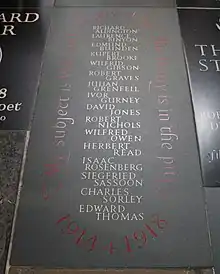
- Richard Aldington — buried in Sury, Ardennes, France
- Laurence Binyon (author of "For the Fallen") — buried in Reading, Berkshire
- Edmund Blunden — buried in Holy Trinity Church, Long Melford, Suffolk
- Rupert Brooke (author of "The Soldier") — buried in Skyros, Greece
- Wilfrid Gibson (one of the Georgian poets)
- Robert Graves (author of "I, Claudius" and the only poet of the sixteen, still alive at the time of the commemoration) — buried in Deià, Mallorca, Spain
- Captain Julian Grenfell — buried in Boulogne Eastern Cemetery, Boulogne-sur-Mer, Pas-de-Calais, France
- Ivor Gurney — buried in St Matthew's Church, Twigworth, Gloucestershire
- David Jones — buried in the Ladywell and Brockley Cemetery, Lewisham, London
- Robert Nichols — buried in St Mary's Church, Lawford, Essex
- Second Lieutenant Wilfred Owen (author of "Dulce et Decorum est" and "Anthem for Doomed Youth", and recipient of the Military Cross) — buried in the Ors Communal Cemetery, Ors, Northern France
- Sir Herbert Read — buried in Stonegrave, North Yorkshire
- Isaac Rosenberg — buried in the Bailleul Road East Cemetery, Saint-Laurent-Blangy, Pas-de-Calais, France
- Captain Siegfried Sassoon — buried at St Andrew's Church, Mells, Somerset
- Captain Charles Sorley — also commemorated at the Loos Memorial, in France
- Corporal Edward Thomas — buried in the Commonwealth War Graves Cemetery, Agny, France
20th-century martyrs
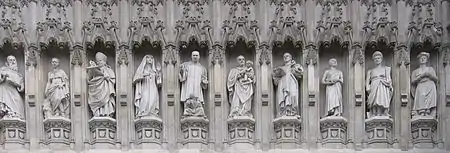
Above the Great West Door, ten 20th-century Christian martyrs from across the world are depicted in statues; from left to right:
Formerly buried (removed)
Harold I of England was originally buried in the abbey, but his body was exhumed, beheaded, and thrown into a fen, in June 1040. The body was later rescued and re-buried in the church of St. Clement Danes, Westminster.
A number of Cromwellians were also buried in the abbey, but later removed, on the orders of Charles II, and buried in a pit in St Margaret's churchyard, adjoining the abbey. A modern plaque on the exterior wall of the church records the names of those who were disinterred:
Marie Joséphine of Savoy, titular Queen of France and wife of Louis XVIII of France, died in exile in England in 1810 and was buried in the Lady Chapel.[26] In 1811, under her husband's orders, her body was exhumed and removed to Cagliari Cathedral, Sardinia.
In November 1869, at the request of the Dean of Westminster and with the approval of Queen Victoria, the philanthropist George Peabody was given a temporary burial in the abbey, but was later moved and buried in Salem, Massachusetts.
Proposed burials and memorials
- Thomas Carlyle burial: Upon Carlyle's death in 1881, Arthur Penrhyn Stanley made an offer of burial in Westminster Abbey. Carlyle had anticipated and rejected this, taking issue with the Church of England's burial service as well as the spectacle of the event, saying that "Westminster Abbey would require a general gaol delivery of rogues before any man could be at peace there".[27] In accordance with his will, he was buried with his family in Hoddam, Scotland.[28]
- Richard III burial: After the discovery of Richard III's remains in September 2012, a controversy arose as to whether or not he should be interred at Westminster Abbey or some other suitable location. His remains were ultimately buried in Leicester Cathedral.[29][30]
- Captain Sir Thomas "Tom" Moore memorial: Following his death in February 2021, TV presenter Carol Vorderman suggested Moore should have a memorial stone placed in Westminster Abbey, in recognition of his fundraising efforts in the run up to his 100th birthday during the COVID-19 pandemic.[31]
References
- Dunton, Larkin (1896). The World and Its People. Silver, Burdett. p. 26.
- Westminster Abbey Mrs. A. Murray Smith, published 30 August 1904
- "Woking Crematorium". Internet. The Cremation Society of Great Britain. Archived from the original on 3 August 2010. Retrieved 28 November 2010.
- "Sebastian Charles". Internet. The Dean and Chapter of Westminster. Retrieved 19 September 2015.
- "Elizabeth, Duchess of Northumberland – Westminster Abbey". Archived from the original on 31 December 2015. Retrieved 30 September 2013.
- "Stephen Hawking memorial service set for June". Westminster Abbey. March 2018. Retrieved 31 March 2018.
- "Stars turn out for Stephen Hawking memorial at Westminster Abbey". BBC News. 15 June 2018. Retrieved 15 June 2018.
- "The Tomb of The Unknown Warrior". British 1. Archived from the original on 20 September 2016. Retrieved 29 August 2016.
- "Edward V & Richard Duke of York". Westminster Abbey. Retrieved 7 June 2022.
- Stanley, Arthur (1886). Westminster Abbey. London: John Murray. p. 499.
- Squire, William Barclay (1885). . In Stephen, Leslie (ed.). Dictionary of National Biography. Vol. 02. London: Smith, Elder & Co.
He was buried in the west cloisters of Westminster Abbey on 28 May.
- pixeltocode.uk, PixelToCode. "Laurence of Durham". Westminster Abbey. Retrieved 27 October 2022.
- pixeltocode.uk, PixelToCode. "William de Humez". Westminster Abbey. Retrieved 27 October 2022.
- Cook, James F. (2004). Governors of Georgia: 1754–2004. Macon: Mercer University Press. ISBN 978-0-86554-954-8.
- "Charles Whitworth, Baron of Galway". Westminster Abbey – Charles Whitworth, Baron of Galway. Westminster Abbey. Retrieved 18 September 2014.
- "Sir Lewis Robessart, Lord Bourgchier". Westminster Abbey. Retrieved 27 May 2020.
- "Sir Thomas Ingram". Westminster Abbey. Retrieved 14 January 2020.
- pixeltocode.uk, PixelToCode. "Sir Arthur Ingram". Westminster Abbey.
- "Robert & Olave Baden-Powell". Westminster Abbey. Retrieved 1 August 2018.
- Coutu, Joan (2006). Persuasion and propaganda monuments and the eighteenth-century British Empire. Montréal: McGill-Queen's University Press. p. 160. ISBN 9780773576643.
- "Commemorations – David Lloyd George". Westminster Abbey. Retrieved 15 June 2018.
- "NAA – Former Prime Ministers Of Australia, Menzies after office". Archived from the original on 3 March 2016. Retrieved 6 February 2016.
- Robert Holden and Desmond Gregory (2004). "Villettes, William Ann". Oxford Dictionary of National Biography (online ed.). Oxford University Press. doi:10.1093/ref:odnb/28284. Retrieved 9 September 2017. (Subscription or UK public library membership required.)
- "Poets". Net.lib.byu.edu. Archived from the original on 22 September 2008. Retrieved 15 November 2012.
- Robert Blake – Westminster Abbey, Westminster Abbey
- Cf. "The Countess de Lisle", The Times (16 November 1810): 3; "The Queen of France's Funeral", The Times (28 November 1810): 3.
- Wilson, David Alec (1923–1934). Carlyle. 6 vols. London: Kegan Paul, Trench, Trubner & Co., LTD. p. 6:281.
- Wilson, David Alec (1923–1934). Carlyle. 6 vols. London: Kegan Paul, Trench, Trubner & Co., LTD. p. 6:471.
- Brown, John Murray (3 February 2013). "Tug-of-war brews over 'king in car park'". Financial Times. Retrieved 4 February 2021.
- Hodgson, Nick; Loeb, Nick; Lydall, Ross (6 February 2013). "Let battle begin: should Richard III have State funeral at Westminster Abbey?". Evening Standard. Retrieved 4 February 2021.
- "Carol Vorderman: Captain Sir Tom Moore 'deserves stone in Westminster Abbey'". East London & West Sussex Guardian. 4 February 2021. Retrieved 4 February 2021.
Notes
- In 1674 the remains of two boys were exhumed from the Tower of London and at the orders of Charles II, they were interred in the wall of the Henry VII Lady Chapel. Westminster Abbey says this: "The urn was opened on 6th July 1933 to examine the bones to try to ascertain if they were human remains. Not all the bones were there as some had been lost or given away when they were found in 1674. The remaining bones were of two young children. The Lady Chapel was closed during the examination and on 11th July the bones were carefully wrapped up and replaced in the urn by the Dean with a parchment recording what had been done. He then read part of the burial service and the urn was re-sealed."[9]
- In the 19th century, researchers looking for the tomb of James VI and I partially opened the underground vault containing the remains of Elizabeth I and Mary I of England. The lead coffins were stacked, with Elizabeth's resting on top of her half-sister's.[10]
- The position of the tomb of King James was lost for two and a half centuries. In the 19th century, following an excavation of many of the vaults beneath the floor, the lead coffin was found in the Henry VII vault.[10]
_2013.jpg.webp)
